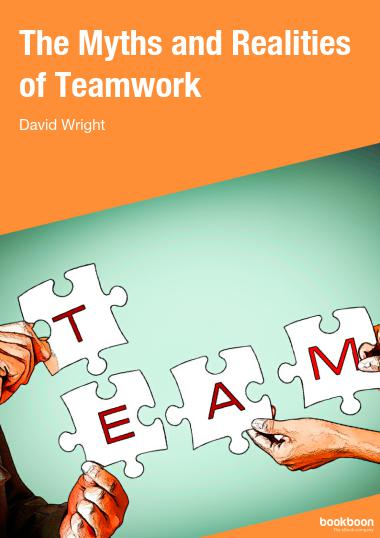David Wright on what makes great teams and leaders


There’s always something new to learn about team work. Author David Wright knows this well, which is why he called his eBook “The Myths and Realities of Teamwork“. Have a closer look at this expert interview!
1. How can a leader trust their team without losing control?
I would start with the premise that, if the team leader fails to demonstrate trust in the team and/or individuals then the leader has already lost control of the team. The words trust and control, in terms of team leadership, do not sit well together.
Trust is a key ingredient in team leadership and if the leader does not trust the team members through valuing their contribution for ideas and inputs, then he or she will fail to lead; control would suggest distrust. For the leader to stay in ‘control’ at all times, the team leader’s assumption must be that he or she knows what is best for the team, always. This can never be the case, as no individual holds all the best solutions and wisdom greater than the team as a whole. The Leader must be comfortable with empowering people to do what is best.
The leader has the opportunity to retain some control through the review and feedback process and helping team members to learn and grow. It is in the planning and the review process that the leader can show leadership; however, in the execution of tasks he or she has to demonstrate trust.
The leader’s focus needs to be about developing more leaders and the team’s output; not control or the feeling of being in control!
2. Do you have an example of when work done by a team would have been done better by an individual?
Teams are at their best when the task is challenging and difficult, that is, difficult for any one individual on their own in terms of time for delivery or complexity. However, if the task is simple or well within the functional capacity of an individual, what is the point of team engagement? My exception to this is in volunteer or ‘social’ groups where the key goal may be teamwork itself through tasks. Tasks for these groups are the vehicle for delivering the team environment.
Organisations are full of examples where the original task was difficult and had a significant learning curve, requiring teamwork. Over time with that knowledge in place, with the help of technology, the task has the capacity of being completed by an individual, yet some of the old team structures have continued to lead to unnecessary duplication of work. I have witnessed this many years ago in the telecoms industry where teams ran complex communications exchanges and now with remote access one individual can run many exchanges without moving from his/her computer. The rest of the ‘old’ team pursued ‘hobbies’ to keep themselves occupied.
I have a current personal situation where I wish to change telecom supplier including the broadband package. I have now dealt with four different departments and seven weeks later I am still waiting for the final result. How much simpler would it be if one person took responsibility for delivery rather than ‘everybody’!
It also happens in customer service situations when individuals do not have the authority to act or make a decision without referring to a line manager or other personnel when they have sufficient experience to make a sound judgement themselves.
3. In the chapter “Team Skills”, you mention the “Six Thinking Hats”. This seems like an excellent way to involve different ways of thinking in a team meeting! Did you come up with this?
I only wish I had thought of the thinking process; however, full credit goes to Edward de Bono, who is described as the foremost expert in the world in teaching thinking as a skill. He has demonstrated how the Six Thinking Hats process gives greater assurance of whole team engagement and greater success, with ‘thinking /process time’ reduced by more than half. Teams understand the Six Thing Hats concept very quickly and while it has many serious applications the team can generate great fun in coming to solutions.
I have used the process in very emotional industrial relations environments with positive outcomes; all the more fruitful when the emotions under Red Hat are given an opportunity to be expressed and also the chance to experience sober realisation under the sharing of facts (no opinions) with the White Hat.
Six Thinking Hats was written in 1985 and was followed up by a less familiar book of Six Action Shoes; written on a plane journey from London to Sydney in 1991. Both are a recommended read.
4. How can you distinguish between “assertive” and “aggressive”? I imagine some people confuse the feelings behind these words.
‘Normal and high level aggression is easy to spot in terms of the words, tone, facial expression and general body language. The underlying element in all aggression is tipping the balance (scales of justice) in favour of the aggressor. True assertiveness gives equal rights to everyone including oneself.
Low aggression is the real enemy of building respect within a team, as it is often less obvious than high aggression, where another team member including the leader may be taking rights for themselves and ignoring the rights of other team members. In the book in Chapter 4 of the Myths and Realities of Teamwork I give an example of low aggression and I repeat the example below.
Low level aggression is often hard to spot in that their language can be pleasant. An example of low-level aggression is, “Tom, you are very good at spreadsheets. Can you complete these calculations for me? It should only take a few minutes”. This could be viewed as low level aggression because:
– There was no attempt to establish if Tom was busy and had time
– Tom was praised because something was being sought (false praise)
– The ‘few minutes’ was understated to assist with Tom’s engagement
If we had been witnesses to this event, we might well see additional low level aggression behaviours at play, such as tone and body language.
Assertive behaviour always shows respect by protecting the rights of others while maintaining one’s own rights.
5. You’ve written a chapter called “Leadership for all”. If a team member is used to “following” and “listening”, how can they be convinced that they can also become a leader?
Leadership for all recognises that some people may wish to take on leadership roles only when the team needs their input and or expertise to be successful.
This can be simply saying to the team that they do not understand what is happening. That takes courage when everyone else seeks to know what is happening within the team and the reality is that there are probably several team members whose participation is impaired by not understanding fully the task or the process. There is generally a relief all round when the ‘truth’ is spoken. Speaking out against the general flow or consensus takes courage and demonstrates leadership at a key moment with the team process.
Where there are subject matter experts in a team, then the team needs those people to step forward and show leadership to generate the best outcome for the team, even if their preference is to “follow” and “listen”.
In leadership for all, it is recognised that not everyone wants to be the leader of the whole team all the time; however, there are critical moments when an individual must step forward and take ’charge’, demonstrating leadership. This is what is meant by the phrase ‘leadership for all’.
I believe everyone has the capacity for leadership: for some it is an easy natural step and for others it is a challenge and takes great resolve; however, it is within their reach should they choose to lead.




